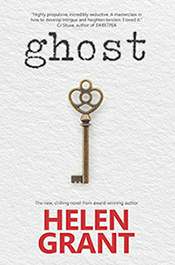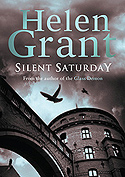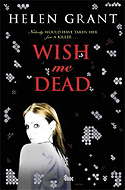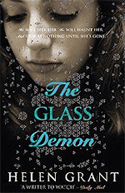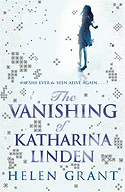I'm an absolute sucker for lost movie stories, especially when they're old ones. Vintage technology has an eldritch quality all of its own, a topic touched on some years ago by Aaron Worth of Boston University in his talk about M.R.James's Uncanny Cinematography, at an M.R.James Conference in Leeds. Film technology is now long established, and grainy footage or crackling audio can be just as creepy to modern audiences as dusty books and ancient manuscripts were to Victorian ones.
Anyway, I couldn't resist adding my own contribution to the trope with my latest novel Jump Cut. Obviously it’s not the first book on these theme, nor will it be the last, so I thought I'd put together a short list of lost movie novels. This is not an exhaustive list! Goodreads has one with 31 books on it, though it's lost films and cursed movies, which is a wider definition. But these are the ones which sprang to my mind.
Of these five books:
- I have read two
- I have written one
- There are two I have not read (yet!) but which look intriguing
Here are the books in publication date order!
Ancient Images by Ramsey Campbell (first published 1989, now available in a new edition from Flame Tree Press)
I read Ancient Images when it first came out, but over 3 decades later I mainly remembered scenes of the heroine driving through endless fields of wheat, accompanied by a lowering feeling of dread. So I ordered a new copy and read it again. Here's the blurb: "Tower of Fear is a lost horror film starring Karloff and Lugosi. A film historian who locates a copy dies while fleeing something that terrified him. His friend Sandy Allan vows to prove he found the film. She learns how haunted the production was and the survivors of it still are. It contains a secret about Redfield, a titled family that owns a favourite British food, Staff o’ Life. The Redfield land has uncanny guardians, and one follows Sandy home. To maintain its fertility Redfield demands a sacrifice, and a band of new age travellers is about to set up camp there…"
It's an interesting contribution to the lost movie trope because – at least to me – the lost film isn't the most frightening thing about this book. The unnerving element comes from Sandy's frequent sightings of vaguely ominous creatures seen out of the corner of the eye: a tramp, a dog, a workman on all fours, a scarecrow – or are they? These manifestations don't always pierce Sandy's upper consciousness, being half-noticed and then dismissed, but they recur so frequently that they amount to a subtle and horrible pursuit.
When Sandy finally watches the lost movie, the viewing takes place in a semi-derelict cinema in the midst of renovation, and the projectionist goes off site for the second reel, leaving her alone with the film, the smell of brick dust, and the shifting shadows. Very creepy.
The Last Days of Leda Grey by Essie Fox (2016)
This novel is, I suspect, the most literary of my list of five, though I'm taking a bit of a flier since I haven't read two of them yet! It has a vivid, to me almost poetic style. It's a fever dream of a book. Here's the blurb: "During the oppressive heat wave of 1976 a young journalist, Ed Peters, finds an Edwardian photograph in a junk shop in the seaside town of Brightland. It shows an alluring, dark-haired girl, an actress whose name was Leda Grey.
Enchanted by the image, Ed learns Leda Grey is still living – now a recluse in a decaying cliff-top house she once shared with a man named Charles Beauvois, a director of early silent film. As Beauvois’s muse and lover, Leda often starred in scenes where stage magic and trick photography were used to astonishing effect.
But, while playing a cursed Egyptian queen, the fantasies captured on celluloid were echoed in reality, leaving Leda abandoned and alone for more than half a century – until the secrets of her past result in a shocking climax, more haunting than any to be in found in the silent films of Charles Beauvois."
I absolutely loved the fact that one of the long-unseen movies was based on H.Rider Haggard's She, which was a great favourite of mine when I was a youngster. The other memorable aspect of this book was the blurring of real and unreal, and whether we can believe the evidence of our eyes.
Silver Nitrate by Silvia Moreno-Garcia (July 2023)
Alas, this is one of the books I haven't read yet. Silvia Moreno-Garcia has written ten novels, although the award winning Mexican Gothic, which is on my bookshelf, is the one a lot of people have heard of. Here's the blurb: "Montserrat has always been overlooked. She's a talented sound editor, but she's left out of the boys' club running the film industry in '90s Mexico City. And she's all but invisible to her best friend Tristán, a charming if faded soap opera star, even though she's been in love with him since childhood.
Then Tristán discovers his new neighbour is the cult horror director Abel Urueta, and the legendary auteur claims he has a way to change their lives - even if his tales of a Nazi occultist imbuing magic into highly volatile silver nitrate stock sounds like sheer fantasy. The magic film was never finished, which is why, Urueta swears, his career vanished overnight. He is cursed.
Now the director wants Montserrat and Tristán to help him shoot the missing scene and lift the curse . . . but Montserrat soon notices a dark presence following her.
As they work together to unravel the mystery of the film and the obscure occultist who once roamed their city, Montserrat and Tristán might just find out that sorcerers and magic are not only the stuff of movies…"
Ah, that volatile nitrate film. The BFI website says: "Simply put, once alight, it is incredibly difficult, if not impossible, to extinguish until it has burnt itself out and no film (fuel) remains. One burning poundweight of cellulose nitrate can reach temperatures of around 4,444°C, and is 15 times more combustible than a similar weight in wood. This heat, combined with the production of toxic gases from the combustion process, can present an immediate threat to life." This is a characteristic of vintage film which did not escape either myself or Essie Fox…
Jump Cut by me, Helen Grant (September 2023)
Like my previous novels Ghost and Too Near The Dead, Jump Cut is set in rural Scotland, and the isolation in which my heroine finds herself is the backdrop to a grim game of cat and mouse. Film researcher Theda wants to know all about lost movie The Simulacrum, but she can only obtain the information by paying for it with the details of her own tragic past. Pitted against her is 104-year-old former film star Mary Arden, one of the characters I have most enjoyed writing, ever. She's a joyously malicious, brazen old besom.
Here's the blurb: "The Simulacrum is the most famous lost movie in film history – would you tell someone your darkest secrets, just to lay hands on a copy? 104-year-old Mary Arden is the last surviving cast member of a notorious lost film. Holed up in Garthside, an Art Deco mansion reputed to be haunted, she has always refused interviews. Now Mary has agreed to talk to film enthusiast Theda Garrick. In return she demands all the salacious details of Theda’s tragic past. Only the hint of a truly stupendous discovery stops Theda walking out. But Mary’s prying questions are not the only thing Theda has to fear. The spirit of The Simulacrum walks Garthside by night, and it will turn an old tragedy into a new nightmare..."
And finally…
Horror Movie by Paul Tremblay (due out 2024)
Obviously I haven't read this one (yet), but it has all the gripping ingredients: a notorious film never properly released, real life tragedy, and a single surviving cast member. I await it eagerly!
Here's the blurb: "In June 1993, a group of young guerilla filmmakers spent four weeks making Horror Movie, a notorious, disturbing, art-house horror flick.
The weird part? Only three of the film’s scenes were ever released to the public, but Horror Movie has nevertheless grown a rabid fanbase. Three decades later, Hollywood is pushing for a big budget reboot.
The man who played “The Thin Kid” is the only surviving cast member. He remembers all too well the secrets buried within the original screenplay, the bizarre events of the filming, and the dangerous crossed lines on set that resulted in tragedy. As memories flood back in, the boundaries between reality and film, past and present start to blur. But he’s going to help remake the film, even if it means navigating a world of cynical producers, egomaniacal directors, and surreal fan conventions—demons of the past be damned.
But at what cost?"
So those are my five lost movie novels, and if you can think of others (I'm sure there are lots) do let me know in the comments.
I'm also interested in movies about lost movies (John Carpenter's Cigarette Burns springs to mind, with its madness-inducing film La Fin Absolue du Monde) so would love to hear of any recommendations in that line. There is also, in a reversal of the books-about-lost-movies theme, room for a list of movies-about-lost-books, but that is one for another day.















